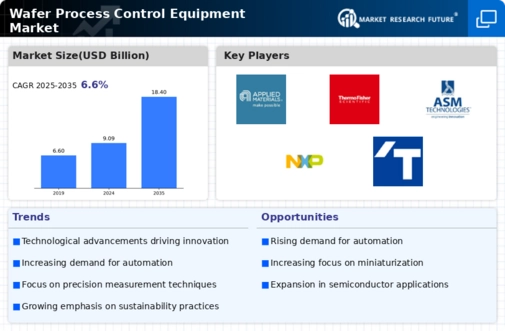Market Analysis
In-depth Analysis of Wafer Process Control Equipment Market Industry Landscape
The Wafer Process Control Equipment market is characterized by a set of dynamic and interconnected forces that collectively shape its behavior and trends. One of the fundamental dynamics driving the market is the continuous evolution of semiconductor technology. As the demand for smaller, more powerful electronic devices increases, semiconductor manufacturers invest in advanced wafer process control equipment to meet these evolving requirements. The rapid pace of technological advancements, such as the development of smaller nanometer processes, further fuels the demand for sophisticated equipment capable of ensuring precision and reliability in semiconductor fabrication.
Market dynamics are also heavily influenced by the cyclical nature of the semiconductor industry. Fluctuations in demand for electronic devices and components can lead to variations in wafer production volumes, impacting the need for process control equipment. Economic conditions, consumer spending patterns, and global events all contribute to the cyclical nature of the semiconductor market, influencing the dynamics of the Wafer Process Control Equipment market in tandem.
Moreover, the competitive landscape plays a pivotal role in shaping market dynamics. The presence of numerous players, each striving for technological supremacy and market share, fosters a climate of innovation and continuous improvement. Companies engage in research and development efforts to stay ahead of competitors, resulting in the introduction of new features, enhanced functionalities, and more reliable wafer process control equipment. The interplay of competition fosters an environment where companies must adapt quickly to technological advancements to remain relevant and competitive.
Global supply chain dynamics also impact the Wafer Process Control Equipment market. Given the intricate network of suppliers, manufacturers, and distributors spanning multiple countries, disruptions in the supply chain can have profound effects on the availability and pricing of wafer process control equipment. Geopolitical tensions, trade policies, and natural disasters can disrupt the flow of materials and components, leading to challenges for market players in terms of production timelines and costs.
Environmental considerations are increasingly influencing market dynamics as well. With a growing emphasis on sustainability and eco-friendly practices, semiconductor manufacturers are seeking wafer process control equipment that aligns with stringent environmental standards. The adoption of equipment designed to minimize energy consumption, reduce waste, and comply with environmental regulations is becoming a key consideration for both manufacturers and end-users, influencing the market dynamics and driving the development of greener technologies.
Regulatory dynamics also play a critical role in shaping the Wafer Process Control Equipment market. Compliance with safety standards, intellectual property rights, and export controls is essential for market participants. Changes in regulations can impact the production processes, distribution channels, and market entry strategies, requiring companies to stay vigilant and adaptable to evolving legal frameworks.
The integration of artificial intelligence (AI) and machine learning (ML) technologies is introducing a new dimension to market dynamics. The use of AI and ML in wafer process control equipment enhances capabilities such as predictive maintenance, real-time monitoring, and adaptive process control. This technological shift not only improves efficiency but also opens new possibilities for innovation and market growth.








Leave a Comment